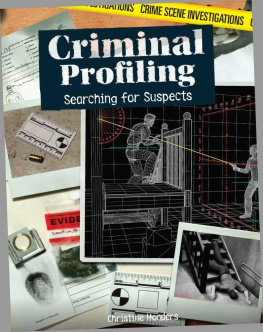Published in 2018 by
Lucent Press, an Imprint of Greenhaven Publishing, LLC
353 3rd Avenue
Suite 255
New York, NY 10010
Copyright 2018 Greenhaven Press, a part of Gale, Cengage Learning
Gale and Greenhaven Press are registered trademarks used herein under license.
All new materials copyright 2018 Lucent Press, an Imprint of Greenhaven Publishing, LLC.
All rights reserved. No part of this book may be reproduced in any form without permission in writing from the publisher, except by a reviewer.
Designer: Deanna Paternostro
Editor: Vanessa Oswald
Library of Congress Cataloging-in-Publication Data
Names: Honders, Christine.
Title: Tracking serial killers: how to catch a murderer / Christine Honders.
Description: New York : Lucent Press, 2018. | Series: Crime scene investigations | Includes index.
Identifiers: ISBN 9781534560895 (library bound) | ISBN 9781534560901 (ebook)
Subjects: LCSH: Serial murder investigation--United States--Juvenile literature. | Serial murderers--United States--Psychology--Juvenile literature. | Criminal behavior, Prediction of--United States--Juvenile literature.
Classification: LCC HV8079.H6 Y35 2018 | DDC 363.259523--dc23
Printed in the United States of America
CPSIA compliance information: Batch #BS17KL: For further information contact Greenhaven Publishing LLC, New York, New York at 1-844-317-7404.
Please visit our website, www.greenhavenpublishing.com. For a free color catalog of all our high-quality books, call toll free 1-844-317-7404 or fax 1-844-317-7405.
Contents
Foreword
Introduction:
The Killers Next Door
Chapter One:
Serial Killer Task Force
Chapter Two:
Profiling
Chapter Three:
Public Attention
Chapter Four:
The Crime Lab
Chapter Five:
Forensic Technology
Notes
For More Information
Index
Picture Credits
About the Author
Foreword
F or decades, popular television programs and movies have depicted the life and work of police officers, detectives, and crime scene investigators. Many of these shows and films portray forensic scientists as the brains responsible for cracking cases and bringing criminals to justice. Undoubtedly, these crime scene analysts are an important part in the process of crime solving. With modern technology and advances in forensic analysis, these highly trained experts are a crucial component of law enforcement systems all across the world.
Police officers and detectives are also integral members of the law enforcement team. They are the ones who respond to 911 calls about crime, collect physical evidence, and use their high level of training to identify suspects and culprits. They work right alongside forensic investigators to figure out the mysteries behind why a crime is committed, and the entire team cooperates to gather enough evidence to convict someone in a court of law.
Ever since the first laws were recorded, crime scene investigation has been handled in roughly the same way. An authority is informed that a crime has been committed; someone looks around the crime scene and interviews potential witnesses; suspects are identified based on evidence and testimony; and, finally, someone is formally accused of committing a crime. This basic plan is generally effective, and criminals are often caught and brought to justice. Throughout history, however, certain limitations have sometimes prevented authorities from finding out who was responsible for a crime.
There are many reasons why a crime goes unsolved: Maybe a dead body was found too late, evidence was tampered with, or witnesses lied. Sometimes, even the greatest technology of the age is simply not good enough to process and analyze the evidence at a crime scene. In the United States during the 20th century, for example, the person responsible for the infamous Zodiac killings was never found, despite the earnest efforts of hundreds of policemen, detectives, and forensic analysts.
In modern times, science and technology are integral to the investigative process. From DNA analysis to high-definition surveillance video, it has become much more difficult to commit a crime and get away with it. Using advanced computers and immense databases, microscopic skin cells from a crime scene can be collected and then analyzed by a forensic scientist, leading detectives to the home of the culprit of a crime. Dozens of people work behind the scenes of criminal investigations to figure out the unique and complex elements of a crime. Although this process is still time-consuming and complicated, technology is constantly improving and adapting to the needs of police forces worldwide.
This series is designed to help young readers understand the systems in place to allow forensic professionals to do their jobs. Covering a wide range of topics, from the assassination of President John F. Kennedy to 21st-century cybercriminals, these titles describe in detail the ways in which technology and criminal investigations have evolved over more than 50 years. They cite eyewitnesses and experts in order to give a detailed and nuanced picture of the difficult task of rooting out criminals. Although television shows and movies add drama to the crime scene investigation process, these real-life stories have enough drama on their own. This series sticks to the facts surrounding some of the highest-profile criminal cases of the modern era and the people who work to solve them and other crimes every day.
Introduction
The Killers Next Door
I n 2005 in Wichita, Kansas, a man named Dennis Rader, former Cub Scout leader and active member of his church, was working as a city compliance supervisor. He appeared to everyone to be a regular guy. Maybe he was a bit overzealous in being a stickler for the rules, such as measuring the length of peoples grass and getting a little too much enjoyment from the limited authority he had over the local residents, but the married father of two was described by many as friendly and pleasant.
At the same time, the Wichita police were trying to find a serial killer, one whofrom 1974 until 1991caused the citizens of the city to live in fear. He called himself the BTK (Bind, Torture, and Kill) Killer and would break into peoples homes, cut their phone lines, and murder them in slow, torturous ways. Between 1977 and 1978, the first thing the women in Wichita did when they got home was check their phone for a dial tone. For years he not only got away with these murders, but also would write letters, leave packages, and make phone calls to the media and the police, taunting them. The BTK Killer had not struck since 1991, but in 2004, when the media began reporting on the 30th anniversary of his crimes, he sent letters, a photo of one of the victims, a word puzzle, and even an outline for the BTK Story to the police. These communications finally led authorities to the identification and arrest of Dennis Rader. The community was stunned that a quiet, normal-looking man could have committed such heinous acts.
Rader pled guilty and opened up during the trial about his crimes, explaining how he researched and selected each murder, which he called projects, up to the grisly details of each victims final moments. When speaking about the murder of Shirley Vian, who he strangled to death while her three children were locked in a bathroom, he said he would have killed the children as well if their phone had not rung, causing him to flee. Rader said in court, I probably would have hung the little girl. Like I said, Im pretty mean or could be. But on the other hand, Im veryyou know, Im a nice guy.















